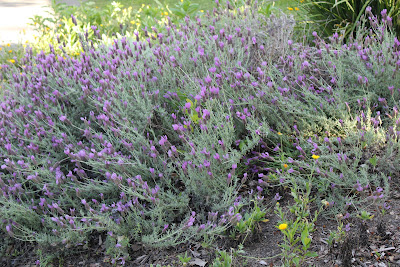I have a J-shaped flower bed that runs about 100 feet along the east side of my
property. Because of its size and unshaded exposure to the Sacramento Valley
sun, which makes temperatures soar into the triple digits in the summer, selecting plants that
will thrive and flower in these harsh conditions has been a challenge.
I’ve
planted coreopsis, butterfly and humming bird bushes, Nile and fortnight lilies,
various thorned shrubs and lots of lavender, which seems to flourish in the bed’s
constant exposure. The purple blooms attract honey bees and the flowers can be used in flower arrangements. Sometimes when I’m watering or weeding, I break off the
lavender leaves and run them between my fingertips to enjoy the essence.
Over time,
as I watched this and that experimental plant succumb to the summer heat or winter
frost, the lavender keeps growing and spreading. My neighbors
have commented on the beauty of these plants while on their evening walks through the
neighborhood. I’ve planted more lavender
with the same satisfying result.
Part of my
success is the plant's origins in the in the Mediterranean region. The ancient Greeks called the lavender herb nardus, after the Syrian city of Naarda
(possibly the modern town of Dohuk, Iraq, according to Wikipedia). It
was also commonly called nard. Lavender was one of the holy herbs used
in the biblical Temple of Jerusalem to prepare the holy essence of God, and nard
is mentioned in the Song of Solomon
– nard and saffron, calamus and cinnamon, with every kind of incense tree, with myrrh and aloes, and all the finest spices.
Plant
historians say that during Roman times, lavender flowers were sold for
100 denarii per pound, about the same as a month's wages
for a farm laborer. Its Latin name was lavandārius, from lavanda
(things to be washed), from the verb lavāre (to wash). The Greeks
discovered early on that lavender if crushed and treated correctly would
release a relaxing fume when burned. In medieval times powdered lavender was
used as a food condiment.
But, I
find in my research about the history of lavender, that the plant that grows so
profusely in my garden has a dark side. Scanning the language of flowers, which
is a lexicon of floral statements compiled over centuries for offering flowers as gifts. It seems lavender represented “distrust”
to the Victorians. During that era flowers were used as shorthand to convey
certain sentiments without speaking them.
Floral
historians say the primary sentiment for lavender is based in the superstition
that poisonous asps (cobras and vipers) live under lavender plants; therefore,
the "distrust" of lavender plants. This is probably the most extreme example
of a flower sentiment that's not really associated the actual flower blossom.
Since learning this, however, I’m more careful about weeding in the lavender and don't give the stems as gifts, unless I want to send a message.
If you’d
like to try your hand at growing lavender, there’s a new book from Timber
Press: The Lavender
Lover's Handbook: The 100 Most Beautiful and Fragrant Varieties for Growing,
Crafting, and Cooking
Author Sarah Berringer Bader says there's something about lavender that causes people to go
slightly nuts. I'm sure the aromatic flowers and foliage play a part, but I
think the real reason, she says, lies in those images of fields of purple basking under a
Mediterranean sun, with maybe an olive grove in the background. We'd all like
to have a piece of that.
“Well, the last time I checked, Provençal lavender farms
were a little pricey, as were round-trip tickets to Avignon,” she says. “But as
long as you have some well-drained soil, full sun, and live in Zone 5 or
warmer, you too can have a bit of that purple (or white, or pink, or
blue-violet) magic.”
But, you’ll need to decide which lavenders to grow. Did you
know that there are more than 450 cultivars, not to mention about 39 species?
No? I didn't either, at least not until I picked up The Lavender
Lover's Handbook: The 100 Most Beautiful and Fragrant Varieties for Growing,
Crafting, and Cooking. There's a ton of great information
here.
Not only does the author tell you how to grow lavender (even
in areas with cold winters or high humidity), she's whittled down those 450
cultivars to the 100 most likely to make you happy or impress your neighbors.
Whether your main interest is flower color, fragrance, size, bloom time or
craft and culinary potential, you'll find varieties to suit your needs.
My advice? Pour yourself a tumbler of pastis or a glass of
Beaumes de Venise, set your chair in a shady spot in the garden, listen to the
drone of the honey bees, and dream away. Provence may not be as far away as you
thought.
See you in the garden. Wear lavender. Au revoir!




No comments:
Post a Comment